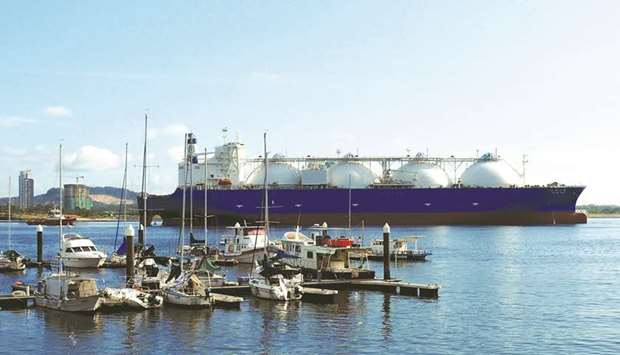Future is for LNG as derivatives trading takes off

Bloomberg/Singapore
With natural gas demand growing faster than for any other fossil fuel, LNG futures may be finally taking off.
Derivatives represented about 2% of global LNG production at the beginning of 2017 as an array of contracts around the world struggled to gain traction. But by the end of last year, volumes had grown to almost 23%, led by a burgeoning Intercontinental Exchange Inc contract based on S&P Global Platts’ Japan-Korea Marker spot price assessments.
While volumes are a long way off established global energy benchmarks such as Brent crude – where trade dwarfs worldwide oil production many times over – the accelerating growth in LNG derivatives illustrates how the market is maturing. An explosion in supply, from the US to Australia, is bringing more market participants and a shift away from traditional pricing.
“There’s more short-term physical trading indexed to JKM and new counterparties active in the market,” said Tobias Davis, head of LNG–Asia at brokerage Tullett Prebon. “This creates more liquidity and in turn, builds more confidence in trading the swap and using it as a viable hedging tool.”
There are now at least six derivative contracts for LNG, ranging from US Gulf Coast futures on ICE to Kuwait-India on Singapore Exchange Ltd. The most established by far is ICE’s Japan-Korea Marker, launched in 2012. More than 17,000 contracts traded in December, a 10-fold increase from January 2017. The next most active is CME Group Inc’s futures contract, also based on S&P Global Platts’ JKM assessment. Its monthly volume peaked in November last year at 3,335 contracts.
The need for a liquid LNG benchmark has been the subject of much debate. Traditionally, when oil was used more commonly in power generation and production, it was almost exclusively valued relative to crude oil and brought and sold under long- term contracts. One advantage of that system is that oil has a liquid and established futures market that gives market participants visibility and the confidence to hedge.
But oil and gas don’t move in lockstep and buyers have become increasingly reluctant to be tied to crude markets. The expansion in global supply, most notably with the development of shale reserves that transformed the US into a major natural gas exporter, has opened up other options and stimulated a shift to more spot trading.
About 27% of LNG was sold under spot-or short-term deals in 2017, up from 12% in 2003, according to the International Group of LNG Importers.
That just increased the need for a reliable price benchmark and liquid futures market for hedging. Regional gas benchmarks such as Louisiana’s Henry Hub, the UK’s National Balancing Point or Dutch Title Transfer Facility reflect local fundamentals and therefore may not be ideal proxies for the global LNG trade, where the vast majority of sales are in Asia. So that’s where LNG futures come in.
JKM “is much more trusted, much more accurate, and the paper market is helping make it be more responsive to price movements,” Gordon D Waters, the global head of LNG at ENGIE, said by phone on Friday. JKM contracts could reach the level of NBP or TTF “most likely within the next 5 years.” NBP and TTF volumes both averaged about 37,000 contracts a day in 2018.
There’s still a long way to go. ICE JKM is still much smaller than other global oil and gas benchmarks. Exchange open interest, or the amount of outstanding bets at the end of every day, accounted for about $2bn at the end of 2018, compared with $36bn for US natural gas and more than $100bn for Brent oil, according to Bloomberg estimates.
For a futures market to be considered truly liquid, volumes should be about 10 times the size of the actual physical trade, according to Total SA, one of the world’s biggest producers and a major participant in the JKM market. With volumes multiplying by about three times a year, JKM should reach that level in about five years, Philip Olivier, Total’s general manager of global LNG, said in October.
Brent and US gas traders also have much more flexibility, as they’re able to buy and sell futures by the second, with prices updating to reflect the fast-moving market. Most JKM LNG trades are still brokered offline and then cleared by exchanges. Contract values are based on a monthly average of Platts assessments, so the price updates once a day when the new assessment is added.
Still, LNG has already surpassed one energy derivative. ICE’s JKM contract now has more value in open interest than the exchange’s Newcastle coal contract. The two fuels, of course, also vie in the real world for space in power plants in some regions.
“If you have a look at how the coal market developed in the mid-2000s, it took over a decade to transition to a liquid exchange order book,” said Gordon Bennett, managing director for utility markets at ICE. “It definitely feels like JKM is evolving quicker.”